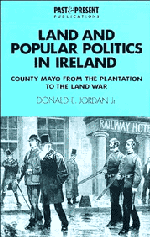Book contents
- Frontmatter
- Contents
- List of figures
- List of maps
- List of tables
- Acknowledgments
- List of abbreviations
- Introduction
- PART 1 COUNTY MAYO PRIOR TO THE FAMINE
- PART 2 THE POST-FAMINE TRANSFORMATION OF COUNTY MAYO
- PART 3 THE LAND WAR IN COUNTY MAYO
- 6 The West's Awake! The early months of the Land War
- 7 The centralization of the agitation, June 1879-April 1880
- 8 Tensions within the Land League in County Mayo, 1880
- 9 The collapse of the land agitation, 1880-1881
- 1 Mayo evictions: explanation of calculations and sources for Table 4.1 and Figure 4.1
- 2 Occupations of suspected Fenians, County Mayo, as recorded in police files, 1866-71
- 3 List of persons whose arrest is recommended under the Protection of Persons and Property Act, 1881, County Mayo
- 4 Explanation of categories and list of Land League meetings for Map 5.2 and Table 3.1
- Bibliography
- Index
- Past and Present Publications
8 - Tensions within the Land League in County Mayo, 1880
Published online by Cambridge University Press: 03 May 2011
- Frontmatter
- Contents
- List of figures
- List of maps
- List of tables
- Acknowledgments
- List of abbreviations
- Introduction
- PART 1 COUNTY MAYO PRIOR TO THE FAMINE
- PART 2 THE POST-FAMINE TRANSFORMATION OF COUNTY MAYO
- PART 3 THE LAND WAR IN COUNTY MAYO
- 6 The West's Awake! The early months of the Land War
- 7 The centralization of the agitation, June 1879-April 1880
- 8 Tensions within the Land League in County Mayo, 1880
- 9 The collapse of the land agitation, 1880-1881
- 1 Mayo evictions: explanation of calculations and sources for Table 4.1 and Figure 4.1
- 2 Occupations of suspected Fenians, County Mayo, as recorded in police files, 1866-71
- 3 List of persons whose arrest is recommended under the Protection of Persons and Property Act, 1881, County Mayo
- 4 Explanation of categories and list of Land League meetings for Map 5.2 and Table 3.1
- Bibliography
- Index
- Past and Present Publications
Summary
Each affiliated branch must communicate directly with the central executive in Dublin … in all matters relating to finances, reports, and organisation. County centralisation invites dangers and attacks which could not so easily affect a solid compact body under the complete guidance of a central executive council with the entire resources of the organization at its control.
Michael Davitt, December 1880Here we are, not alone in Castlebar but in every town in the West of Ireland, surrounded by those who have been evicted calling for assistance from the League without avail.
James Daly, August 1881Tension within the League leadership in Mayo and between it and the Land League central executive was rooted in a long-standing controversy over whether Irish grievances could best be redressed through a centralized political movement directed by professional revolutionaries (the United Irishman and Fenian tradition) or through a locally based agitation (the Whiteboy and Ribbonmen tradition). Unlike the earlier tactical controversies within Irish nationalism, the one that arose in Mayo in 1880 did not center around whether local or national grievances should be supreme. Rather, the issue was whether the Irish National Land League executive, which by the fall of 1880 was increasingly influenced by the more prosperous farmers of southern and eastern Ireland, could direct the agitation in Mayo more effectively than could local politicians who could claim to be in closer accord with the county's small farmers.
- Type
- Chapter
- Information
- Land and Popular Politics in IrelandCounty Mayo from the Plantation to the Land War, pp. 264 - 282Publisher: Cambridge University PressPrint publication year: 1994

